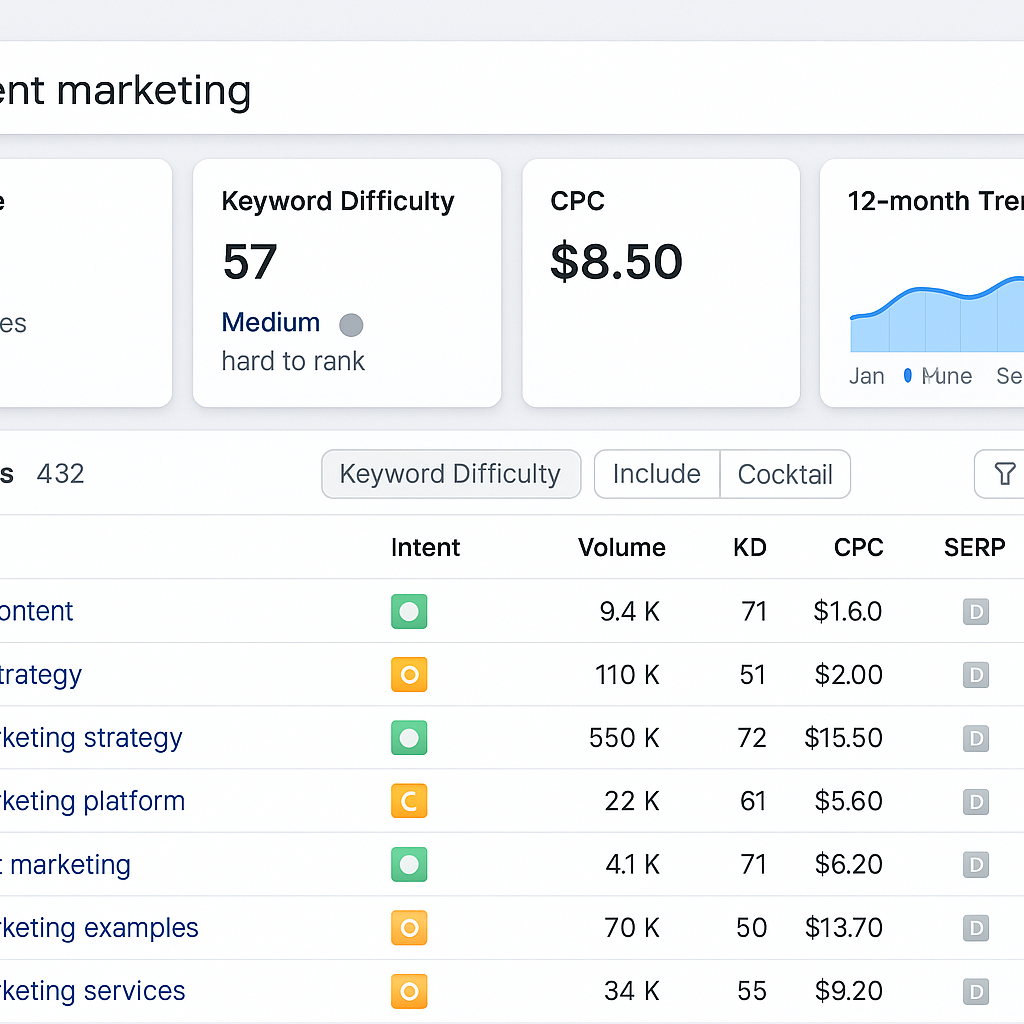Introduction
Content marketing in 2025 is about crafting experiences, not just writing blog posts. Whether you’re a solo creator, agency owner, or marketing team lead, the right set of tools determines how effectively you can plan, create, and measure results. With dozens of new AI platforms and automation suites launching every month, finding what truly works can feel overwhelming.
This guide covers the best content marketing tools for 2025 — helping you streamline research, writing, optimization, design, scheduling, and analytics — so you can focus on strategy instead of stress.
Planning and Research
Every successful campaign starts with solid research. Tools like Ahrefs and Semrush continue to dominate keyword and competitor analysis. Ahrefs’ Content Explorer uncovers what’s performing best in your niche, while Semrush’s Topic Research tool reveals keyword clusters and popular questions to inspire high-value posts.
If you need quick topic ideas, AnswerThePublic visualizes user searches, making it easy to see what people really ask online. Combine that with Google Trends or Exploding Topics to catch emerging trends before competitors do.

Writing and Creation
Once your ideas are clear, writing becomes the core of execution. AI has changed how marketers write in 2025 — tools like Jasper AI and Copy.ai generate long-form drafts in seconds while maintaining tone and SEO structure. Jasper’s SurferSEO integration gives real-time optimization suggestions inside your draft, ensuring every paragraph aligns with search intent.
For editing, Grammarly refines grammar and tone, while Hemingway App improves readability by highlighting complex sentences. If you’re serious about on-page SEO, SurferSEO and Frase guide you through ideal word counts, headers, and semantic keywords based on top-ranking pages.
When it comes to visuals, Canva remains the easiest choice for creating banners, thumbnails, infographics, and social media images. Its AI-powered Magic Design now generates branded templates automatically using your colors and logo. For multimedia, Descript lets you edit podcasts and videos by simply editing text — perfect for turning webinars or interviews into shareable content snippets.
🖼️ Suggested image: workspace with laptop and Canva open
Alt text: “Canva dashboard showing social media templates”
Organization and Collaboration
Modern content teams thrive on structure. Notion offers an all-in-one workspace where you can plan topics, manage a content calendar, and store brand guidelines. It integrates with Google Drive, Trello, and Slack — keeping everything organized in one dashboard.
For more advanced workflows, ClickUp adds task automation, time tracking, and progress dashboards, perfect for agencies or multi-member teams. If you prefer simplicity, Trello uses boards and cards for managing ideas, drafts, and publishing dates at a glance.
🖼️ Suggested image: visual calendar with post deadlines
Alt text: “Marketing team planning content schedule using Notion board”
Distribution and Promotion
Creating content means little if nobody sees it. In 2025, social automation tools are essential. Buffer helps schedule and analyze posts across LinkedIn, X (Twitter), Instagram, and Facebook from one place. For larger teams, Hootsuite offers more powerful analytics, approval workflows, and AI-generated captions.
To save time, automation platforms like Zapier connect everything — automatically posting your new WordPress article to social channels or sending it to your newsletter list.
Email marketing still plays a major role. ConvertKit and MailerLite make it easy to send personalized campaigns, automate sequences, and track open and click-through rates. Together with your social scheduler, they form the backbone of a consistent distribution system.
🖼️ Suggested image: dashboard showing scheduled social posts
Alt text: “Social media calendar automation overview”
Optimization and SEO
SEO tools ensure your content actually gets found. Yoast SEO remains the go-to plugin for WordPress users, offering readability checks, keyword focus, and schema markup. Rank Math, another strong contender, adds advanced analytics and a cleaner interface for power users.
For content ideation and link-building opportunities, BuzzSumo shows which articles perform best in your industry and helps identify influencers to collaborate with. If you want to earn authoritative backlinks, sign up for HARO (Help a Reporter Out) — journalists often seek expert quotes, giving your site valuable exposure and SEO benefits.
🖼️ Suggested image: SERP results and keyword ranking chart
Alt text: “SEO ranking improvement chart showing upward trend”
Analytics and Reporting
The final — and most overlooked — part of content marketing is measurement. Google Analytics 4 (GA4) provides comprehensive insights into user journeys, traffic sources, and conversions. Pair it with Google Search Console for keyword-level data.
For behavior insights, Hotjar visualizes scroll depth, click maps, and user sessions so you can see exactly where visitors lose interest. Combine that with Looker Studio (formerly Data Studio) to build visually engaging performance dashboards that report metrics to your clients or team in real time.
🖼️ Suggested image: analytics dashboard visualization
Alt text: “GA4 dashboard with traffic, engagement, and conversions metrics”
AI, Automation, and the Future of Content
Artificial intelligence is reshaping how content is planned, created, and optimized. The latest AI writers don’t just rephrase text — they analyze tone, intent, and even historical performance to suggest better headlines or meta descriptions.
Tools like ChatGPT Enterprise, Jasper AI, and Copy.ai integrate seamlessly with CMS systems to speed up ideation and initial drafts. AI also powers predictive analytics, where tools can forecast which topics or headlines are likely to perform best before publication.
Automation has become equally crucial. With Zapier and HubSpot Workflows, marketers can now automate repetitive actions such as cross-posting, sending notifications, or updating analytics sheets. This shift allows teams to focus more on strategy and creativity rather than manual labor.
Building Your Ideal Tool Stack
Choosing the right combination of tools depends on your goals. A small business might rely on Notion, Canva, Jasper AI, and Buffer for an affordable yet powerful setup. Larger organizations often combine Ahrefs for research, SurferSEO for optimization, and Hootsuite for social publishing — integrated via Zapier for efficiency.
When designing your content stack:
- Start small with free versions to understand functionality.
- Choose integrations that reduce manual work.
- Focus on tools that complement each other rather than overlap.
🖼️ Suggested image: infographic showing connected marketing tools
Alt text: “Diagram of interconnected marketing tools for research, creation, and analytics”
Common Mistakes to Avoid
Even experienced marketers fall into traps when using tools:
- Over-tooling: Too many subscriptions can create confusion and drain budgets.
- Ignoring data: If you’re not analyzing what works, you’re guessing.
- Lack of consistency: Without a content calendar, audiences lose interest.
- Publishing without optimization: Skipping SEO steps reduces discoverability.
- Neglecting updates: Outdated statistics and broken links harm trust and ranking.
Keep your setup lean, consistent, and regularly reviewed.
Conclusion
The best content marketing tools of 2025 share one common goal — they make marketing smarter, faster, and more data-driven. Instead of juggling dozens of disconnected apps, build a focused stack that aligns with your workflow.
Start with essentials like Ahrefs for research, Jasper AI for writing, Canva for visuals, and GA4 for analytics. Add automation tools as your output grows, and continuously refine your system based on results.
At the heart of it, success in content marketing isn’t just about having the newest tools — it’s about using the right tools strategically to deliver content that informs, engages, and converts.
🖼️ Suggested hero image: marketer using a laptop surrounded by analytics and design visuals
Alt text: “Modern workspace with marketer managing multiple content marketing tools”


